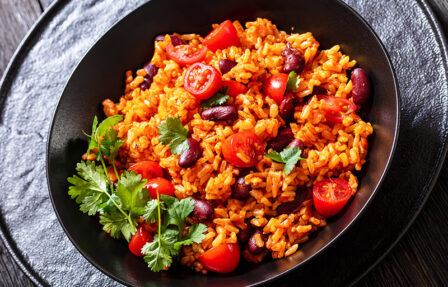Pulses


Pulses include beans, chickpeas, lentils and peas. Some of the most common among these that you might see in your local supermarkets are kidney, butter and black beans. Red and green lentils are a fantastic staple for the cupboard too. Pulses are rich in minerals, vitamins, protein and so much more goodness, and they count as 1 of your 5-a-day! You can buy them dried and soak and cook them yourself, or make it even simpler and buy them canned and ready to eat. You can drain, rinse and add a tin of beans or lentils to so many dishes – try adding them for the last few mins of cooking to a one-pot dinner like chilli, stews, casseroles or curries.
CHECK OUT: Our guide to beans and pulses featuring Bettina Campolcci Bordi

Nutrition
Pulses are a great source of plant protein as well as being rich in fibre and minerals like iron and potassium. These support energy levels and our normal body functions to ensure we’re running at out best.

Shopping Guide
You can buy your pulses canned or dried. If you’re in a time crunch, canned pulses like kidney beans can be a great addition to the kitchen cupboard. Consider picking up a dried bag of pulses, these require soaking prior to cooking but you’ll get more bang for your buck.

Storage
Both tinned and dried pulses need to be stored in a dry and dark area. Once a bag of pulses like lentils are opened they need to be kept in an airtight container away from any heat.

Serving Suggestions
Tinned pulses can be cooked from the can, simply drain the excess liquid prior to heating. Dried pulses require soaking before cooking, the length of time required varies between them so take a look at their cooking instructions to ensure you’re soaking them for long enough.

Seasonality
Buying veg in season is not only great for the planet, it can be good for your wallet, too! Seasonal veg are often cheaper and frequently taste better, so can be a better time to try with a child as the often sweeter, riper taste is more enjoyable.
At Its Best:
January - December

Engage
Here are some of our favourite ways to engage kids with pulses:
Arts & Crafts
Start simple with some non-food based engagement. This is especially helpful for a fussier child or those with sensitivities around food.
For pulses, why not get a selection of different dried or cooked beans and lentils and try and capture the different colours, textures and shapes with colouring pencils? Or make a rainmaker with an empty, clean lidded crisp tube or milk bottle – pour in some dried beans or lentils, decorate them and seal the lid tightly before shake, shake, shaking!

Sensory
Sensory exploration can be a wonderful introduction to physically interacting with veg. Turn it into a positive, pressure-free experience by starting off with the golden rules of “You don’t need to try and you don’t need to like.” Reassuring a child that, while they have a chance to taste a veg, they don’t have to, and are not expected to like it if they do, can make them more happy to engage with it.
Why not explore pulses through touch and sight? There are so many different kinds of beans and lentils. Get a few types that are a good mix in size/shape and colour, dried vs cooked, etc. and see if you can and your child can describe them. What do they look like? What colours, shapes and patterns can you see? What do they remind you of? What do they feel like? Are they rough, smooth, slimy, hard?

Kids in the Kitchen
Children who help to prep and cook veg are more likely to eat it. If you feel your child is ready to help and could benefit from it, keep the stress and mess to a minimum by choosing one simple task for them to do as part of the prep, meaning they can be involved and feel like the recipe is in part ‘theirs’, but also not make the process too much longer or more complicated.
For a younger child, why not give them the job of rinsing the tin of beans or lentils? Pour the tin(s) into a sieve or colander and let them put it under the tap to rinse.
For an older child, it could be a great opportunity to teach cooking over heat. Add the beans or lentils to the dish you are making and show them how to stir it in safely over the heat. You could also teach them how to use a can opener and where the sharp parts of the tin are so they know for the future.
DOWNLOADS:
Use our Kitchen Ninja chart and videos to find simple ways for kids to help in the kitchen.


Your Food
Find your go-to meals in our family favourites section and see what veggies work best with them.
Find out how to add more veg to your suppers here.
Recipes

Serving
The moments before food is offered can be a perfect opportunity for engagement that can help make it more likely a child will eat it!
The first thing to do is remove the pressure. If the veg doesn’t get eaten, it’s not the end of the world. There will be other days, other dinners, other chances. Fun is key here – try not to worry about mess, perfect table manners, or playing with food. Instead, focus on making the process of getting the food to the plates, readying the table, and the actual eating relaxed.
The best principles for success here are the Three Rs (role modelling, rewarding, re-offering) which you can read about here.
But there is one more way you can serve for success, and that is giving your child a role. You don’t have to do this every time, just encourage them in their strengths through it when you can.
Here are some of our favourite ideas:
Design a menu
Come up with a silly name or story for a dish
Help with making a meal plan and choosing veg for dinners or snacks
Help to serve up the meal on dishes, lay the table or create a centrepiece to be involved in the physical ‘serving up’ process.
The Wonderful World of Veg
Check out our vegepedia. When to buy in-season. How to store them to keep for longer. How to engage children with each veg, and simple ideas of how to prepare and cook them for maximum taste and minimum waste. Select a veg…















